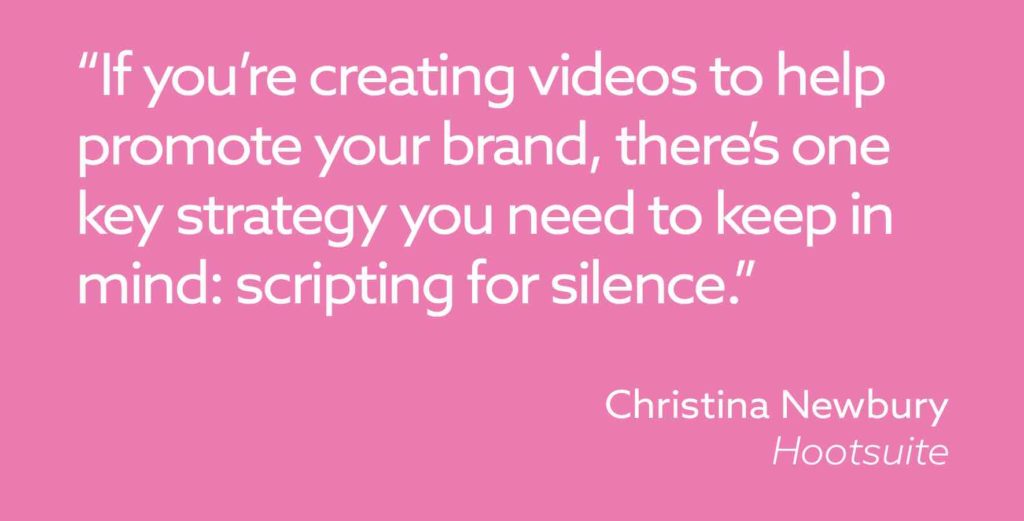Marketers are increasingly choosing to create videos that work without sound. This is due to Facebook and other platforms that auto-play videos in silence in your news feed, amongst other reasons listed below. But how do you do this right? What examples are there? Is it even the right thing to do? In this post, we discuss these questions and more!

Quote by Christina Newbury, Hootsuite:
Reasons to do it
There are some good arguments for creating an explainer video without sound.
- Social media and ad platforms often auto-play in silence
- People at work will often watch in silence, or at low volume, so as not to disturb colleagues. Not all workers have a headset handy.
- Videos may need to play in locations with background noise, e.g. at a cafe or at customer locations.
- To reach those with hearing impairments.
- Location-specific requirements like at retail booths or conferences (you can find 9 ideas for your conference videos here).
In effect,…
You are making sure that your video can be watched in more real-life situations. This gives you more juice out of your investment in the video.
Reasons not to do it
If your video has lots of content or is fairly technical, then following this strategy may backfire slightly because people may find the video confusing. Showing a lot of text will without voice makes a video hard to follow and it also lengthens the video duration which can increase your production costs considerably.
How to Script Up these Suckers
These videos work best with short, simple sentences and concepts. That way the scenes can transition into each other better and the viewer doesn’t feel confused.
This is easier if you’re dealing with cold, hard facts but if your video is very story-driven without typography then we recommend simplifying the storyline drastically. That’s because different people perceive the same visual narrative in totally different ways (you’d be amazed to what extent). The key in that instance is therefore extreme simplicity… keep it to only a single key message or plot line.
Examples of Videos that work without Sound
The below video is an example that uses animation. In this style, we morph one scene into the next
In the video below we use a limited amount of text and morph one scene into the next.
Here’s another example.
For technical products, it’s also possible to script for silence. In the below case, the content is complex for you and me but works just fine for their audience using only typography and no voiceover.
Scripting for Semi-Silence
Another strategy is to show key messaging points in typography but still use a voiceover. The idea is that viewers who watch in silence will still be able to see get the gist of things, and then they can tune in if they find it interesting. A good idea here is to make the intro portion of the video work in silence, which is effective especially on social channels that auto-play content.
A Short Note on Visuals
If you’re going the silent route then it can really help to have bold visuals. This helps draw attention and hopefully focus it in the right places. Also, you need to pay more attention to the visual flow of the story. For example, if there are too many visuals or they are too complex then the video will have less impact.
Retail Displays
In a retail display, you’ll want to catch a shopper’s attention and then get them to stay and watch more of your video or check out the physical product. The human brain finds it hard not to read something that’s been put in front of them, especially if that thing is dynamic and attention-grabbing. Here’s an example of a video that was made for a physical display on the shop front.
The key to these videos is that the viewer can start watching anywhere in the video and then when the video loops back to the start then they can continue watching if it’s of interest.
Conference Booths
There are a few ways that silent videos are used in conference booths. Firstly, they can be part of the booth display, e.g. an animation running in the background. The goal here is to grab attention, look pretty, and get some key (simple) messaging across. A second common use is to have a video showing silently on a computer screen that audience members can walk up to, put a set of headphones on, and then watch in more detail. This is sometimes helpful because audience members may be interested in your product but don’t want to talk to a human just yet, or the human may be busy talking to someone else already. This also has the advantage that exhibitors can direct people to the video after talking to them. Here below is an example of a silent background video, created for use in a conference.
That brings us to the end of our little article. Got a perspective to share? Let us know!
